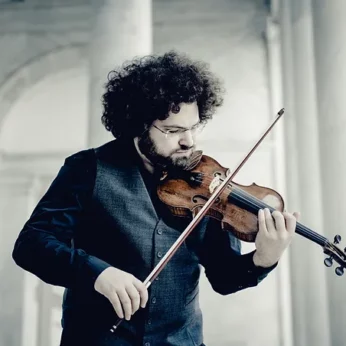Composer: Maurice Ravel (b. 1875 - d. 1937)
Performance date: 30/06/2023
Venue: St. Brendan’s Church
Composition Year: 1922
Duration: 00:20:46
Recording Engineer: Gar Duffy, RTÉ
Instrumentation: vn, vc
Instrumentation Category:Duo
Artists:
Jonian Kadesha -
[Violin]
Vashti Hunter -
[Cello]

Sonata for violin and cello [1920-22]
When the First World War broke out, Ravel made a supreme effort to finish his Piano Trio so that he could enlist. As it turned out the army and the fledgling air force rejected him several times on the grounds of his poor health and slight physique (he was under 5’4″ high). Eventually in March 1915 he got himself accepted as a lorry driver by means of much string-pulling and a discreetly mistaken measurement of his height. However the authorities were correct and his health was not up to the work and he was discharged in 1917, soon after the death of his beloved mother. In the six years from 1914 to 1920 he only wrote two works, Le Tombeau de Couperin and La Valse, as a result of illness, depression and despair. The Duo Sonata took him eighteen months to compose, which gives some idea of the difficulties he was having. This devil of a duo is giving me a lot of trouble, he wrote to one friend in 1921.
Later Ravel wrote that he considered this work a turning point in the evolution of his career. Economy of texture is here pushed to the extreme. Renunciation of harmonic charm; an increasingly marked reaction in favour of melody. Then when he thought he had it finished, he realised that the scherzo was too long and rewrote it from the beginning. It looks nothing much, this thing for two instruments: there is almost a year and a half’s hard labour in it. In that time Milhaud would have been able to produce four symphonies, five quartets and several settings of Paul Claudel.
The paradox at the heart of this duo is how to get the two instruments to collaborate without actually merging their harmonic identities. Even in the first movement when violin and cello seem to work most graciously together, there is a tension between them that prevents either instrument overwhelming the other. In the rewritten scherzo the two instruments are awarded different key signatures, which ensures their harmonic divergence. It is a brilliant movement bursting with colour and energy with a funny little Trio at the off-centre that literally explodes. The slow movement begins as thoughtful conversation before rising to frenzied debate and then returning to the original melodious ideas. The last movement is based on a fanfare motif that is broken into by a lyrical episode that recalls the opening movement. The fanfare is then ever more fantastically developed until it sounds as though a full quartet is playing, leading to stunning finish.
Francis Humphrys
Copyright © 2024 West Cork Music. All rights reserved.
Designed and developed by Matrix Internet